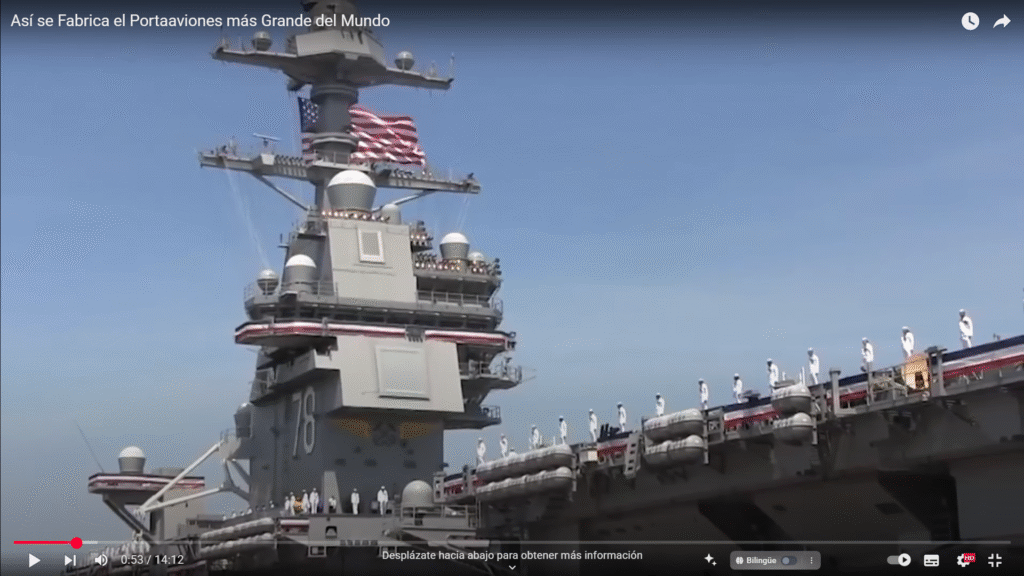How do you build a floating city weighing more than 100,000 tons using technology never before tested? The answer has a name: the USS Gerald R. Ford, the largest, most expensive, and most ambitious aircraft carrier ever built. But its story goes far beyond steel and nuclear reactors: it’s a lesson in how power is built in the 21st century.
The Project That Many Said Was Impossible
When the United States announced it was going to build the most advanced aircraft carrier in history, some called it madness. And with good reason. The Gerald R. Ford was not only larger than any previous ship, but also incorporated more than 23 technological innovations that had never existed on any other vessel. These included an electromagnetic launch system (EMALS), multifunction radars, a more compact control island, and nuclear reactors capable of operating for 25 years without refueling.
But all of this stemmed from a problem: the old aircraft carriers were becoming obsolete, and updating them was no longer viable. In 2000, the Department of Defense decided to start with a clean slate. And with that, one of the most challenging naval construction projects of all time began.
Where Do You Build Something That Doesn’t Fit Anywhere?
Not even the largest shipyards on the planet were prepared to assemble a structure of this size. The solution was to build the Ford as if it were a modular building: more than 150 gigantic blocks, some weighing more than 900 tons, assembled with millimeter precision. The acceptable margin of error: 2 mm.
And that was just the beginning. Each block came with kilometers of internal wiring, hydraulic systems, technical rooms, and reinforced structures that had to function as a single unit. In total, more than 1,000 km of cables, two fully shielded nuclear reactors, and countless components requiring surgical precision were installed.
Problems, Delays and a Race Against Time
Nothing went according to plan. The EMALS system failed during initial tests. The ammunition elevators didn’t work. The sensors failed. Costs soared beyond $13 billion, and criticism poured in from Congress. Some called it “the experiment that got out of control.”
However, inside the shipyard, more than 5,000 people worked day and night with one clear goal: to prove it was possible. After years of redesigns, new software, extreme testing, and political pressure, the Ford finally hit the water.
Extreme Tests: From TNT to Earthquakes
The final test? Shock trials : underwater explosions of up to 18 tons of TNT to simulate a real attack. The explosions generated a small earthquake off the coast… but the aircraft carrier held firm. Unfazed.
That was the moment the United States knew it had made it. The Gerald R. Ford wasn’t just floating, it was working. And not like an ordinary ship, but like a global power platform capable of operating anywhere on the planet within hours.
The New Global Naval Race Is Now Underway
But while the US celebrated its achievement, others watched in silence . China built the Fujian aircraft carrier with similar electromagnetic catapults. France and India are already developing their own supercarriers. Russia is also trying, albeit with more difficulty.
Because today, an aircraft carrier isn’t just a ship. It’s a message. A floating warning. Where there’s one, there’s influence. And supremacy is no longer just technological, it’s strategic.
More than Engineering: A Declaration of Power
The Gerald R. Ford represents much more than a technical achievement. It is the embodiment of a vision: to prove that America can build what no one else can , even if there are no guarantees of success. Its story is a blend of engineering, politics, ambition, risk, and perseverance.
And if this can be done on water… what is being built underground?
Suggested SEO Keywords:
- largest aircraft carrier in the world
- USS Gerald R. Ford
- How the Ford aircraft carrier was built
- electromagnetic aircraft carrier
- United States naval technology
- Emals
- Chinese super aircraft carrier
- US naval military power
- military innovation
Would you also like me to prepare a social media version or a short script for a TikTok or YouTube Shorts video on this same topic?
Ask ChatGPT



